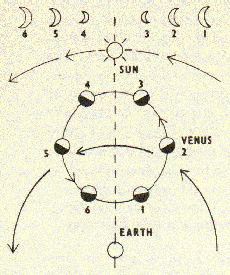
Sunspots
Galileo saw that the Sun had dark patches on it, sunspots. (He eventually
went blind, perhaps from damage suffered by looking at the Sun with his telescope.)
Furthermore, he observed motion of the sunspots indicating that the Sun was
rotating. "Blemishes" on the Sun were contrary to the doctrine of an unchanging
perfect substance in the heavens, and the rotation of the Sun made it less
strange that the Earth might rotate on an axis too, as required in the
Copernican model.
The Phases of Venus
Galileo used his telescope to show that Venus went through
a complete set of phases, just like the Moon. This observation
was among the most important in human history, for it provided
the first conclusive observational proof that was consistent
with the Copernican system but not the Ptolemaic system.
This was because the two systems make different predictions
for the progression of the phases of Venus (see below)
 Ptolemaic System |
 Copernican System |
These discoveries were made from 1608 to 1612, making him quite famous AND at the center of controversy with the Catholic Church. By 1616, Galileo was formally requested by the Church to cease debating (teaching or publishing) his scientific results which supported the Copernican model. From 1616 until around 1630, Galileo did hold off from working on Astronomy. However, he returned to his astronomical research later in life, which eventually got him into deep trouble with the Inquisition. At age 70, he was forced to recant the Copernican system and spent the rest of his natural life under house arrest at his villa.